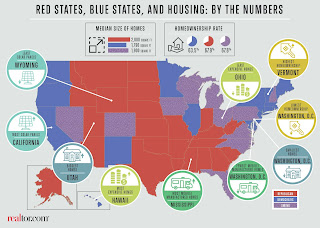The State of the Nation’s Housing - 2016
In it, one can find important stats which can be found here
and there in various real estate articles and publications, - and in some of my
blogs, like:
Inventory (fig. 10, page 10):
-
There are 1.9% fewer existing homes for sale in the US
than one year ago,
-
7.8% fewer entry-level homes for sale,
-
New home sales still at their lowest, for the past 25
years (although the inventory of new homes for sale went up by 8.2% in 2015,
which is a step in the right direction) - see page 9 and 10.
Homeownership: fewer
people own their home in the US:
-
Homeownership rate is much lower than before the 2008
crisis, over all at 63.7% (see page 19),
-
This is the case in pretty much all of the age groups
(page 2).
-
The number of renters has increased by 9 million in
the past 10 years, with vacancy rates falling and rents climbing, as we all
know (especially in the Bay Area). Not so well known: people in their 50s and
60s make up the largest part of the increase in renters.
-
The number of renters paying more than 50% of income
for housing jumped by 2.1 million, to a total of 11.4 million. (page 4).
-
A growing supply of new housing being built may help
ease these conditions. Something to
follow up on …
Affordability:
-
The percentage
of all households that can afford to purchase a median-priced, single-family
home is called the Housing Affordability Index.
It is 60% for the US. Compare
this to California: 30%, and the County of Santa Clara: 20%
-
The share of adults aged 20-39 with student loan debt
went from 22% in 2001 to 39% in 2013, while the average amount owed went respectively
from $17k to $30k; - this has an impact
on the housing market as a whole: fewer homes sell as a consequence. Since housing makes a good part of the
economy, one could deduce that it is not good for the US.
-
Homebuying activity is much lower than before 2007, but
is now on the uptick (pg.21).
Property value appreciation:
-
Very uneven, depending on the area. Some areas still lag in appreciation (pg 11).
Some areas are higher than at the peak before the 2007 crisis, and some are
still way below.
-
Of course, overall, fewer homeowners are “under water”.
The report, for those interested, is a treasure trove of
fascinating information about our society and the US housing situation. In trying to keep some perspective on the
real estate market locally in the Bay Area, I find it enlightening, and offer the following graph that I keep over the years:
click on the graph for better viewing.
Thanks for reading,
Francis
Silicon Valley Real Estate
Smart local Stats and Graphs
non-profit organization worth noting:
Partners for New Generations.
















